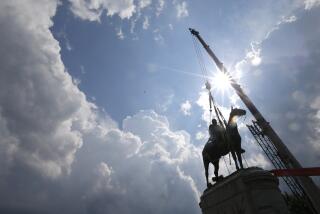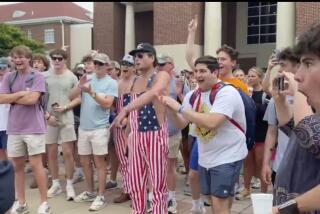Ole Miss Mascot a New Confederate Casualty
- Share via
OXFORD, Miss — OXFORD, Miss. -- At the University of Mississippi, the past clings to the campus like kudzu.
It’s in the face of the marble Confederate who stands over the entrance to the famous Circle. It’s in the Lyceum’s bullet-scarred columns, enduring reminders of the school’s bloody 1962 integration. It’s in the school’s beloved nickname -- Ole Miss.
But as the years have passed, the school has done its best to bring Ole Miss into the New South. It’s all but banished the once-ubiquitous Confederate battle flags from football games. “Dixie” has been scrapped as the unofficial fight song. And the annual spring bacchanalia is no longer known as “Dixie Week.”
Now it appears the next to go is “Colonel Rebel,” the school’s barely reconstructed Confederate mascot, who for generations has cut a dapper figure with his wide-brimmed hat cocked to the side, snow-white goatee and signature cane.
The football program announced this month that old “Johnny Reb” wouldn’t be on the sidelines this coming season -- although he remains an official university trademark and won’t be disappearing from T-shirts and shot glasses anytime soon.
His image, it seems, evokes a little too much history for administrators and the school’s booster club, which has paid a New York consultant $30,000 to study options for a new mascot.
“The Confederacy is behind us,” Athletic Director Pete Boone said. “I just think that it’s time for us to change our whole thought process, our whole image, our whole look and feel about being the team of the 21st century.”
Although Boone insists that it’s only the mascot, not the name, that’s on the table, some alums believe that it’s all but impossible to separate the “Rebel” from “Colonel Rebel.” They see it as only a matter of time before “Rebel” goes the way of the old Stanford Indian, Marquette Warrior and St. John’s Redman.
“If it remains unchecked, we will just be the Mississippi Wildcats or something,” Memphis businessman Perry Mangum wrote to the Clarion-Ledger in Jackson, threatening to cancel his season football tickets. “They are trying to get rid of the Old South imagery.”
The debate is another reminder of what Oxford’s most famous son, William Faulkner, once wrote: “The past is never dead. In fact, it’s not even past.”
*
Comical as it may sound today, Ole Miss became the Rebels because its old nickname, “The Flood,” had bad connotations.
Coming off a 1935 season in which the football team went 9-3, editors of the campus newspaper, the Mississippian, decided a new name was needed to “catch the public eye and fancy.” It launched a contest.
Of 600 entries, five finalists were put to a vote by 21 of the state’s most prominent sports writers. Rebels garnered 18 votes, with Raiders second with two. (Among the other finalists: Stonewalls and Confederates.)
The new nickname made its debut in the fall of 1936 with a 45-0 thrashing of -- of all schools -- Union University. Colonel Rebel made his first appearance, in the school yearbook, in 1937.
By 1947, students were showing up at home football games in big black hats and string ties. Before today’s foam-headed caricature, the on-field mascot was a guy in an honest-to-goodness Confederate uniform, complete with saber and revolver. Sometimes he even rode in on a horse named Traveler, a nod to Robert E. Lee’s faithful steed.
“The little ol’ man who says, ‘Ah say, suh,’ is the spirit of Ole Miss embodied in the figure of a Southern gentleman,” declared a 1953 story in the Mississippian.
At first, the rebel imagery signaled defiance at the notion that a Deep South college couldn’t keep up -- athletically or academically -- with the Harvards of the world. But by the time the National Guard enforced James Meredith’s enrollment, what Mississippians were rebelling against was change.
*
Walking along the brick Circle, Associate Dean Don Cole can still see the hate in the eyes of one student who drove by, waving a Confederate battle flag out the window. He can still smell the beer poured over him and other blacks as they huddled at football games, trying in vain to join in that school spirit.
“I wanted to support the teams, but I couldn’t, quote, ‘Be a Rebel,’ ” said Cole, who was expelled from the school with six other blacks in 1969 for protesting what they saw as the school’s racist ways. “I wanted them also to integrate so that they could do much, much better -- and I could have a lot more to cheer about.”
Seven years after Cole’s ignominious departure, Robert J. “Gentle Ben” Williams became the first black to play football for Ole Miss -- and to be voted “Colonel Rebel” by his peers. Today, blacks make up 13% of the student body of 15,000.
On the 40th anniversary of Meredith’s arrival, the university launched its Winter Institute for Racial Reconciliation.
Even the colonel has changed over the years, morphing from proud military officer to a more laid-back plantation Bourbon.
But there’s no escaping the fact that he’s Confederate to the core.
Boone says rival schools have used Colonel Reb over the years to convince black recruits that Ole Miss might not be the friendliest place for them.
But more than that, he says, he wants to update the program’s image, and he’d like to come up with something a little more intimidating than “an old man with a cane.”
*
The private Ole Miss Loyalty Foundation has engaged the services of New York-based Phoenix Design Works, which recently completed updates of existing mascots for Tennessee, Arkansas and Harvard.
No changes are expected until at least after football season. But already, some are cringing at the prospect.
Sitting on a blanket in the shade of campus’ Grove, Cassi Thrash, 17, wonders what will be left of the Ole Miss her parents and grandparents attended by the time she gets there.
“It’s crazy. They’re taking away everything from everybody,” said the Tupelo-area student, who was on campus for a summer leadership institute named for Republican Sen. Trent Lott, once an Ole Miss cheerleader. “Part of the school’s gone.”
But overall, Boone says, there’s been remarkably little protest.
At a school where football is religion, former quarterback Archie Manning is a god. Although his heroics on the field were more than 30 years ago, he remains the Rebels’ most popular player. Such is his legend that the speed limit on campus was set at a lugubrious 18 mph -- Manning’s old jersey number.
Manning says any claim that the mascot or nickname are racist is just “gossip and propaganda.” But if it’s hurting the university, then Manning says let it go.
“I’m for what’s good for Ole Miss.”
His son, current quarterback Eli Manning, feels the same way. He doesn’t care what they put on the side of his helmet, so long as it’s not a magnolia blossom.
“I didn’t fall in love with this place because of its name or its mascot,” the senior said as he stood in a weight room plastered with banners that scream “Rebel Pride” and “Rebel Tradition.”
Wide receiver Mike Espy, who is black, agrees.
“Tell you the truth, we go out there on Saturdays and we play for Ole Miss. That’s all,” said Espy, still dripping with sweat from a round of sprints. “Rebel? That’s a thing of the past.”
The lack of sound and fury over the change might be because the change was announced during summer session, when most students and alums were away. Or could it be another reflection of a new Ole Miss?
The past may not be dead, Mr. Faulkner. But maybe, just maybe, it might finally be past.
More to Read
Go beyond the scoreboard
Get the latest on L.A.'s teams in the daily Sports Report newsletter.
You may occasionally receive promotional content from the Los Angeles Times.










